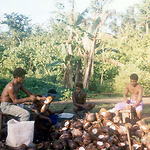Party: Copra Industry
Details
Copra, the dried flesh of the coconut, was first collected from existing coconut trees, and later from specially cultivated plantations that became the mainstay of the Protectorate's economy. Copra from South Pacific Islands never accounted for more than 13 to 15 percent of the world market, and Solomon Islands copra only accounted for around 5 percent of the Pacific production. The industry had been established for some decades in German New Guinea, Samoa and Fiji before large-scale production began in the Protectorate in the 1908. The palms took about eight years to reach maturity. The copra was poor quality and smoke-dried, and could only be used in soap manufacture. (Only sun-dried or hot-air cured copra is suitable for margarine production.) Much of the BSIP labour force was directed to the copra industry. Four large companies dominated-Lever's Pacific Plantations Ltd. (q.v.), W. R. Carpenter & Co. (q.v.), Burns Philp & Co. (q.v.) and Fairymead Sugar Ltd. (q.v.)-and there were many smaller plantations.
The industry was depressed between 1922 and 1924 and in the 1930s, caused by fluctuations of world prices. It cost about £4 to £9 to produce a ton of copra. During the early 1930s, the world price barely allowed any profits and by 1934 the price of copra was down to £1 10s a ton. Inefficient operators were forced out of the industry and the large companies only just survived by suspending less profitable plantations and concentrating on their most efficient operations. Companies such as Burns Philp and Carpenters, who held mortgages on small operator plantations, had to foreclose and became unwilling owners. (Bennett 1987, 219-220)
There was a labour shortage after the Second World War, which meant that it was some years before plantations began to be rehabilitated. Steady progress was made onwards from the late 1940s and by the mid-1950s two-thirds of the prewar figure of 64,000 acres of coconut plantations were being worked. A Copra Board was established in 1953 under the Copra Board Regulation. Its members included government officers and representatives of the planters, missions and commercial interests. The Board's agents were the British Solomon Islands Trading Corporation (q.v.) and the Fairymead Sugar Company Ltd., which, under licence from the Board, purchased all copra except that from Levers Pacific Plantations Pty. Ltd. All of the Board's copra was sold to the U.K. Ministry of Agriculture, Fisheries and Food, while Levers sold their copra in Australia. The U.K. also received an equivalent amount from Australian territories. Attempts were made to improve the quality of Solomons' copra. It began to be graded before purchase, and a new 'Kukum' drier was introduced. In the early 1950s, new plantings were all on indigenous plantations and there was concern over the aging of the palms on company estates. (AR 1955-1956, 23) The annual production of copra remained around 20,000 tons during the mid 1950s, in contrast to the prewar average of 22,000 tons. (AR 1957-1958, 22) The industry did not recover to prewar levels until the middle-to-late 1960s.
| Year | S. Islander Production | PlantationProduction | Total |
| 1967 | 13,770 | 9,747 | 23,517 |
| 1968 | 10,574 | 9,968 | 20,542 |
| 1969 | 14,063 | 10,656 | 24,719 |
| 1970 | 13,488 | 10,736 | 24,224 |
| 1971 | 14,329 | 11,402 | 25,731 |
| 1972 | 11,783 | 9,040 | 20,823 |
| 1973 | 8,963 | 8,869 | 15,832 |
| 1974 | 17,804 | 10,294 | 28,098 |
(AR 1974, 40)
In 1971 copra production reached 25,731 tons, although the world copra market had slumped and the $100 per ton price for first grade copra was the lowest since 1962. (AR 1971, 3) In 1974, 28,098 tons of copra was produced. Plantation production stayed reasonably steady, with an increase in the Solomon Islander smallholdings the most significant. However, first grade copra came predominantly from the plantation sector, with second and third grade copra more likely to come from smallholders. The Copra Board maintained buying points at Honiara, Yandina and Gizo. In 1974, first and second grade copra was worth around $200 per ton, and third grade around $186. (AR 1974, 40)
Related entries
Published resources
Books
- Bennett, Judith A., Wealth of the Solomons: A History of a Pacific Archipelago, 1800-1978, University of Hawai'i Press, Honolulu, 1987. Details
Reports
- British Solomon Islands Protectorate, British Solomon Islands Protectorate Annual Reports (AR), 1896-1973. Details
